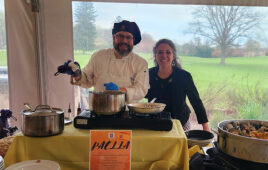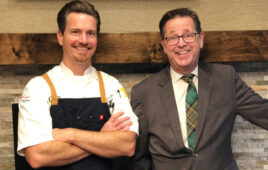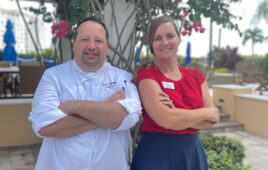Properly managed pre-shift meetings can make steady contributions to F&B success.
Pre-shift meetings—otherwise known as lineups—are a common and necessary practice for successful dining programs. They allow the front of the house to connect with the back, and set the tone for the upcoming service.
These fifteen-minute team huddles typically take place just before the start of a service period, usually dinner. They’re attended by the executive chef, sous chef(s), front-of-the-house manager(s) and the service staff.
Together, the team reviews everything from reservations for the evening and special member requests to goals and upcoming events.
“During our pre-shift, we typically go over daily specials, wine and beer education, food education, and any new policies or service standards,” says Dominic Menna, Executive Chef of The Club at Rolling Hills in Golden, Colo.
When he introduces new menus, Menna has also been known to invite members to pre-shift meetings, to gain valuable and direct feedback.
At Red Rocks Country Club in Morrison, Colo., Executive Chef Orlando Edwards uses the pre-shift meeting to remind staff of the club’s core values and service standards.
“It’s important to be consistent and offer constant reminders about our mission: to satisfy member needs and wants,” Edwards says.

Executive Chef Matthew O’Connor uses the nightly pre-shift to educate service staff about menu changes, which happen monthly at Bonnie Briar CC. He also uses the time to review service from the previous night.
Knowledge is power
Lineups also provide a platform for chefs to pass along menu knowledge, by explaining dishes and ingredients and offering tastings of specials.
“The service staff is an extension of what we do in the kitchen,” says Edwards. “We put a lot of effort into creating each dish, so it’s critical that we arm our servers with as much knowledge as possible, as well as talking points.”
Edwards implements daily quizzes for the service staff to ensure that the information, and not only the tasting, is being digested. “Cohesiveness is important,” he says. “The back of house and front of house have to be on the same page.”
For Bay Colony Golf Club in Naples, Fla., the daily pre-shift is a two-part series.
First, Executive Chef Tim Recher (previously Executive Chef of the Army Navy Country Club in Arlington, Va.), reviews the daily specials with the front-of-house team. He then uses the balance of time to provide culinary education that helps to build the “food IQ” of the entire team.
“Maybe a dish we’re featuring has chanterelle mushrooms,” says Recher. “During pre-shift, we’ll offer a two-minute presentation on what a chanterelle is, why we used it, what it tastes like, where it grows, and why it’s so amazing.”
Pre-shift meetings also offer valuable opportunities to keep the service staff up to date with menu changes, notes Matthew O’Connor, Executive Chef of Bonnie Briar Country Club in Larchmont, N.Y.
“We change our dinner menu monthly, so at the beginning of every month we hold a full menu tasting to walk the service staff through the new menu, dish by dish,” he says. “Each month, I’ll also prepare each dish with the cook who’s responsible for it, so that both the front and back of the house understand the expectations.”
Less is More
While pre-shift meetings can be effective tools for successful service, they can also be challenging for chefs and managers if not managed productively. Any material that is covered must be brief, and too much information can easily be forgotten.
To maximize the benefits of pre-shift meetings, thoroughness, ingenuity, and follow-through are key.
“We use pre-shift to go over any special requests and dietary restrictions, so the servers are armed with knowledge ahead of time,” says O’Connor. “We also discuss challenges from the night before, and praise staff for a job well done.”
To create excitement at Bay Colony GC, Recher follows the adage: “Show. Don’t tell.”
“We don’t just talk about how amazing the heirloom carrots are,” he says. “We bring them in, show them to the team and let them taste them. We give them that first-hand experience and connect with all their senses. It’s far more impactful.”

During pre-shift, Bay Colony GC’s Lead Line Cook, Bailey Cisek (second from right), educates front-of-house staff about two new specials she created.
Looping in the GM
Andy Reetz, General Manager of Champions Run in Omaha, Neb., attends daily lineups along with the shift leader and department manager. “For us, it’s important to share with our team any needed and necessary information about the shift ahead, while also highlighting victories and offering ideas for how we can further improve,” Reetz explains.
As GM, Reetz sets goals for every shift and motivates the staff with “best dressed” contests and letters of thanks, which he distributes during his pre-shift meetings. He also provides his servers with business cards, to help Champions Run’s members better relate to, and know, the staff.
Promoting follow-through, Reetz also conducts post-shift lineups the following day, to revisit material covered the previous day.
“Consistency and follow-through will make the lesson and education sink in,” says Bay Colony’s Recher. “Those repeated experiences are what create habits.
“Pre-shift is part of creating a winning service culture,” he adds. “It helps us each get a little bit better every single day.”




